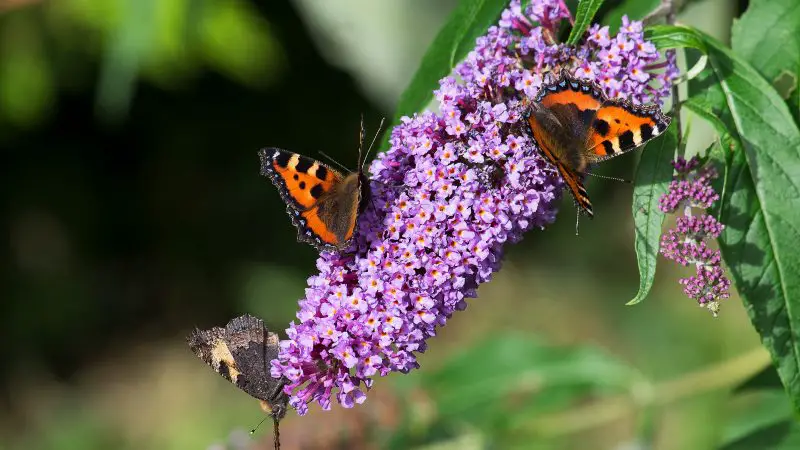Butterfly bushes, scientifically known as Buddleja, are beloved by gardeners and nature enthusiasts alike. Their vibrant, fragrant blooms attract butterflies, bees, and hummingbirds, making any garden a lively oasis. However, to keep butterfly bushes thriving year after year, proper pruning is essential. One of the most common questions gardeners ask is: When do you cut down butterfly bushes for best growth?
Understanding the right timing and method for cutting down butterfly bushes can make a significant difference in their health, flowering, and longevity. This article explores the best practices for pruning butterfly bushes, why timing matters, and how to ensure your plants stay vigorous and beautiful.
Understanding Butterfly Bush Growth and Bloom Cycle

Before delving into the optimal pruning time, it’s important to understand how butterfly bushes grow and bloom. Butterfly bushes typically bloom on new wood, meaning the flowers develop on the current season’s growth rather than on last year’s branches.
During spring, butterfly bushes begin producing new shoots from the base and along existing branches. These shoots will bear the flowers later in the summer and into the fall. If pruning is done incorrectly or at the wrong time, it may remove potential flowering wood, leading to fewer blooms.
In addition, butterfly bushes are fast-growing and can become leggy or overgrown if left unchecked. Regular cutting back helps maintain a dense, attractive shape and promotes more abundant flowering.
Why Timing Matters for Cutting Down Butterfly Bushes
Timing is crucial when it comes to pruning butterfly bushes because it directly affects their flowering potential. Since they bloom on new wood, pruning too late in the season can remove flower buds, resulting in little to no blossoms that year.
Pruning too early or at the wrong time can also cause stress to the plant or expose it to damage from frost or cold temperatures, especially in colder climates. Moreover, improper timing may encourage weak growth that is more susceptible to diseases and pests.
Choosing the right moment to cut down butterfly bushes ensures that you are removing old or dead wood while encouraging robust new growth that will produce flowers in the coming season.
When Do You Cut Down Butterfly Bushes in Different Climates?
The ideal pruning time for butterfly bushes depends heavily on your local climate and hardiness zone. Gardeners in warmer areas have different pruning windows compared to those in regions with harsh winters.
In mild climates where winters are short or mild, butterfly bushes can be pruned earlier in the spring, even before new growth begins. This early pruning removes old wood and encourages the plant to produce vigorous shoots that will bloom abundantly during the growing season.
In colder climates with longer winters and late frosts, pruning is best delayed until after the danger of frost has passed. Pruning too early in these areas can cause damage to the tender new shoots, which may reduce flowering and overall plant health.
In all climates, the general recommendation is to prune butterfly bushes in late winter or early spring when the plant is still dormant or just beginning to wake up. This timing helps the plant focus energy on producing new growth rather than maintaining old wood.
How to Recognize the Best Time for Cutting Down Butterfly Bushes
Observing the plant itself can help determine the perfect moment to cut back your butterfly bush. One key sign is the dormancy period — when the leaves have fallen and the plant is not actively growing.
Late winter, just before new growth starts, is often the ideal time. At this stage, the buds are still closed, but the risk of severe frost has generally passed in many areas.
Another clue is the weather pattern. It’s best to prune during a dry spell with mild temperatures to avoid fungal infections or other diseases that thrive in wet conditions.
Gardeners can also look for signs of old or dead wood that no longer produces leaves or flowers. Removing these sections during pruning not only rejuvenates the bush but also improves air circulation and sunlight penetration.
Proper Techniques for Cutting Down Butterfly Bushes
Knowing when to prune is only half the battle. How you cut down butterfly bushes matters just as much for promoting healthy growth.
The best technique involves cutting the plant back severely but carefully. Most experts recommend reducing the bush to about 12 to 24 inches (30 to 60 centimeters) from the ground. This drastic cut encourages the plant to send up new, vigorous shoots that will bloom later in the season.
Using clean, sharp pruning shears or loppers is important to make smooth cuts and prevent damage or disease entry points. Cuts should be made just above a healthy bud or side shoot to encourage outward growth.
It’s also advisable to remove any dead, damaged, or weak branches during this process. Clearing these parts reduces the risk of disease and helps the plant focus energy on producing strong, healthy new growth.
What Happens If You Cut Butterfly Bushes at the Wrong Time?
Cutting down butterfly bushes at the wrong time can lead to disappointing results. If pruned too late in the season, you may inadvertently remove flower buds that have already formed, resulting in fewer or no blooms.
Pruning too early or during an active growth period can stress the plant, causing weak or sparse new shoots. It might also leave the bush vulnerable to frost damage if cold weather returns after pruning.
Additionally, neglecting to prune at all or pruning incorrectly can cause butterfly bushes to become overgrown, woody, and less attractive. Old wood does not flower as well and can harbor pests or diseases.
Seasonal Pruning Care for Butterfly Bushes
Seasonal care is essential to maintain butterfly bushes after pruning. Once the bush is cut back, providing proper watering and nutrition will support healthy new growth.
During the growing season, butterfly bushes benefit from regular watering, especially in dry periods. However, overwatering should be avoided as it can cause root rot.
Applying a balanced fertilizer in early spring after pruning can give the plant a nutrient boost to promote strong shoots and abundant flowers.
Mulching around the base helps retain soil moisture and regulate temperature, protecting roots through hot summers or cold winters.
How Butterfly Bush Varieties Affect Pruning Time
Not all butterfly bushes are the same. Different species and cultivars may have slightly varying growth habits and hardiness. Some varieties are more cold-hardy and can tolerate earlier pruning, while others may need more caution.
For example, the common butterfly bush (Buddleja davidii) is generally pruned in early spring. However, newer varieties bred for hardiness might have different requirements.
Researching your specific butterfly bush variety or consulting with local gardening experts can help tailor pruning timing to your plant’s needs.
Butterfly Bush Pruning Tips for Beginners
If you are new to gardening or pruning butterfly bushes, starting with the right timing and method will set you up for success.
Patience is key; avoid pruning at the first sign of leaf buds swelling in late winter. Wait until you notice the very start of new growth but before the buds open fully.
Use proper tools and clean them before and after pruning to prevent spreading diseases.
Remember, pruning is not harmful when done correctly. Butterfly bushes are resilient plants that respond well to being cut back hard.
Encouraging More Blooms After Cutting Butterfly Bushes
One of the main goals of cutting down butterfly bushes is to encourage more and bigger blooms. Proper pruning removes old wood that may be less productive and stimulates the plant to grow fresh flowering shoots.
After pruning, consistent care — including adequate sunlight, watering, and fertilization — will support these new shoots.
Ensuring your butterfly bush gets at least six hours of direct sunlight daily is important because insufficient light reduces flowering potential.
In time, with correct pruning and care, your butterfly bush will reward you with abundant, fragrant flowers that attract beautiful butterflies.
Avoiding Common Mistakes When Cutting Down Butterfly Bushes
Many gardeners unintentionally make mistakes when pruning butterfly bushes, impacting plant health and flowering.
One common error is pruning too late in the year, which removes flower buds. Another is cutting back only lightly, which can leave the bush scraggly and reduce bloom quality.
Some prune too severely at the wrong time, causing dieback or frost damage.
Avoid pruning during wet or freezing weather to prevent disease and damage.
Following seasonal guidance and pruning carefully will help avoid these pitfalls.
Signs Your Butterfly Bush Needs Pruning
Sometimes it’s not just about the calendar but the condition of the plant. If your butterfly bush shows signs such as sparse blooms, leggy branches, or dead wood, it likely needs pruning.
A healthy, well-pruned butterfly bush tends to be full, with lots of new growth and numerous flower spikes.
Pruning rejuvenates the bush, promoting air circulation and light penetration, which improves overall plant health.
FAQ About When Do You Cut Down Butterfly Bushes
When is the best time to cut down butterfly bushes?
The best time to cut down butterfly bushes is late winter or early spring, just before new growth begins. This timing encourages vigorous shoots and abundant flowering.
Can I prune butterfly bushes in summer?
Pruning in summer is not recommended as it can remove developing flower buds and reduce blooms. However, light trimming of dead or unruly branches can be done to maintain shape.
What happens if I prune butterfly bushes too late?
Pruning too late can remove flower buds already formed on new growth, resulting in fewer or no flowers during that season.
How much should I cut back butterfly bushes?
It’s best to cut butterfly bushes back hard, leaving about 12 to 24 inches (30 to 60 cm) above the ground. This stimulates strong new growth for the flowering season.
Does pruning improve butterfly bush health?
Yes, proper pruning removes old, dead, or weak branches, improves air circulation, reduces disease risk, and promotes healthier, more vigorous growth with better blooms.
Conclusion: Prune Your Butterfly Bush at the Right Time for Best Growth
Cutting down butterfly bushes for best growth involves timing, technique, and care. Pruning in late winter or early spring before new growth begins is generally the best approach to ensure your plant produces abundant flowers.
Understanding your local climate and the specific butterfly bush variety can help refine the timing. Using proper pruning methods and following up with seasonal care supports healthy, vigorous plants.
By pruning your butterfly bushes correctly, you can enjoy their stunning blooms and the vibrant life they bring to your garden for many seasons to come.






